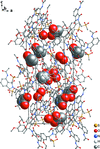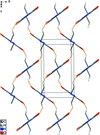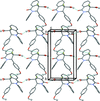issue contents
June 2017 issue

Cover illustration: The crystal structure of [Ni(bztmpen)(CH3CN)](BF4)2, which reveals a pentadentate bztmpen ligand {bztmpen = N-benzyl-N,N',N'-tris[(6-methylpyridin-2-yl)methyl]ethane-1,2-diamine, C30H35N5} and an open site for coordination by other species, can be correlated with its promising reversible electrocatalytic behaviour. The large number of weak C-H X (X = N, F) interactions in the crystal structure is also notable. See: Chen, Ren, Guo & Sang [Acta Cryst. (2017). E73, 825-828].
X (X = N, F) interactions in the crystal structure is also notable. See: Chen, Ren, Guo & Sang [Acta Cryst. (2017). E73, 825-828].
research communications
Download citation


Download citation


The reaction of the ligand N2,N3-bis(pyridin-4-ylmethyl)pyrazine-2,3-dicarboxamide with silver(I) nitrate led to the formation of a three-dimensional coordination polymer.
Download citation


Download citation


The hydrogen-bonding interactions in the crystal structures of N-(5-acetyl-2-methylphenyl)quinoline-2-carboxamide, N-(5-acetyl-2-bromophenyl)quinoline-2-carboxamide and N-(5-acetyl-2-ethynylphenyl)quinoline-2-carboxamide are described. The latter two compounds also exhibit π–π interactions.
Download citation


Download citation


The title dinuclear mercury(II) complex, [Hg2Cl4(C16H19N3)2], synthesized from the pyridine-derived Schiff base (E)-N1,N1-diethyl-N4-[(pyridin-2-yl)methylidene]benzene-1,4-diamine (DPMBD), has inversion symmetry with the five-coordinated HgII centres having distorted square-pyramidal stereochemistry comprising two N-atom donors from a bidentate chelate BPMBD ligand and three Cl-atom donors, one monodentate and two bridging.
CCDC reference: 1531593
Download citation


Download citation


The molecular and crystal structure of the title Schiff base derivative is reported. O—H⋯N hydrogen bonds link molecules into a supramolecular chain along a.
CCDC reference: 1547455
Download citation


Download citation


Trisodium rubidium heptamagnesium hexakis(orthophosphate) exhibits a new structure type, with MgOx (x = 5 and 6) polyhedra linked directly to each other through common corners or edges and reinforced by corner-sharing with PO4 tetrahedra. The resulting anionic three-dimensional framework leads to the formation of channels in which the Na+ cations are located, while the Rb+ cations are located in large interstitial cavities.
CCDC reference: 1546558
Download citation


Download citation


The title compound represents another solvatomorph of apremilast, containing half of an ethanol and half of a water solvent molecule per formula unit
CCDC reference: 1504229
Download citation


Download citation


The structure and electrochemical properties of a nickel tripyridine–diamine complex are reported. The complex has two redox couples at −1.50 and −1.80 V (versus Fc+/0) based on nickel.
CCDC reference: 1548052
Download citation


Download citation


Reaction of silver(I) chloride with 1-(4-nitrophenyl)thiourea and triphenylphosphane ligands of 1:2:1 ratio leads to the mononuclear complex [AgCl(C7H7N3O2S)(C18H15P)2]. In the crystal, bifurcated N—H⋯Cl and a weak C—H⋯O hydrogen bonds link molecules into a two-dimensional network.
CCDC reference: 1546767
Download citation


Download citation


The molecular and crystal structures of the centrosymmetric naphthoxazine derivative is reported. In the absence of hydrogen-bonding and π–π stacking interactions, the crystal structure is stabilized by short C—H⋯π contacts.
CCDC reference: 1547729
Download citation


Download citation


The CaO6 polyhedron and CuO4 quadrilateral are connected by the benzene-1,3,5-tricarboxylate anions to give a three-dimensional polymeric complex.
CCDC reference: 1547715
Download citation


Download citation


The title compound comprises a central pyromellitic diimide moiety with terminal decyl groups, with potential applications as an acaricide, insecticide and mematicide.
CCDC reference: 1548456
Download citation


Download citation


In (CH3)2Sn[S2CN(CH2CH2)2O]2, a skew-trapezoidal bipyramidal coordination geometry based on a C2S4 donor set is found. Secondary Sn⋯S interactions lead to centrosymmetric dimeric aggregates in the crystal.
CCDC reference: 1548414
Download citation


Download citation


The asymmetric unit of the title carbamate, contains two independent molecules (A and B) with similar conformations. In the crystal, they are arranged alternately, forming –A–B–A–B– chains linked by N—H⋯O(carbonyl) hydrogen bonds, which extend along the a-axis direction.
CCDC reference: 1548793
Download citation


Download citation


The crystal structure of Pb2(CrO4)(TeO3) is isotypic with its sulfate analogue Pb2(SO4)(TeO3). Comparison between the structures is made with the COMPSTRU program.
CCDC reference: 1548953
Download citation


Download citation


The title structure consists of 3-aminopyridinium cations and 1′-carboxyferrocene-1-carboxylate monoanions held together by N—H⋯O and O—H⋯O hydrogen bonds.
CCDC reference: 1444115
Download citation


Download citation


The homoleptic nickel–thiosemicarbazonate complex shows structural features including an unusual cis-coordination and trans-anagostic Ni—H intramolecular interactions. In the crystal, complex and DMF solvate molecules build up a one-dimensional hydrogen-bonded polymer along [010].
CCDC reference: 1550129
Download citation


Download citation


The synthesis and structure of the title piperidine derivative is reported. It is one of a second generation of compounds designed and synthesized based on a very potent and selective α9α10 nicotinic acetylcholine receptor antagonist ZZ161C, which has shown analgesic effects in a chemotherapy-induced neuropathy animal model.
CCDC reference: 1550512
Download citation


Download citation


The title compound exhibits a cis conformation with respect to the F atom and the methine H atom. It crystallized from a racemic mixture as a pure diastereomer, hence the unit-cell contains both the 3S,4R- and 3R,4S-enantiomers.
CCDC reference: 1535140
Download citation


Download citation


An unprecedented two-dimensional water–chloride anionic {[(H2O)10Cl2]2−}n network has been structurally identified in a hydrophobic matrix of the nickel(II) complex [Ni(ftpy)2]Cl2·10H2O [ftpy = 4′-(furan-2-yl)-2,2′:6′,2′′-terpyridine].
CCDC reference: 1498201
Download citation


Download citation


The title compound, crystallizes with two independent molecules (A and B) in the asymmetric unit, which are far from planar. The aryl rings are inclined to one another by 58.77 (9)° in molecule A and by 36.95 (8)° in molecule B.
CCDC reference: 703162
Download citation


Download citation


The crystal structures of benzotriazolylpropanamides are governed by π–π stacking between the benzotriazolyl residues and, in the case of primary amide NH2 groups, by N—H⋯O and N—H⋯N bridging.
Download citation


Download citation


A second metastable polymorphic form of the antifungal anilinopyrimidine active pyrimethanil was isolated from an attempted co-crystallization experiment with meso-erythriol in dimethyl sulfoxide (DMSO). The origin of the polymorphic behaviour is revealed in that the conformation of each dimer present in the asymmetric unit of the structure is unique and determined by the rotation of the second molecule in the dimer with respect to the first.
CCDC reference: 1549998
Download citation


Download citation


The transition metal orthophosphate Ag1.655Co1.64Fe1.36(PO4)3 crystallizes in an alluaudite-type structure. The chains characterizing the alluaudite structure are built up from edge-sharing [CoO6] and [FeO6] octahedra linked together by PO4 tetrahedra. The Ag+ cations are located in two types of channels in the resulting framework.
CCDC reference: 1551181
Download citation


Download citation


The transition metal orthophosphate CaNi2Fe(PO4)3 adopts the α-CrPO4 structure type. The structure is built up from two types of sheets, resulting in an open three-dimensional framework that delimits two types of channels in which the CaII cations are located.
CCDC reference: 1551182
Download citation


Download citation


The three title compounds are centrosymmetric. Their packing features chains linked by either pairwise C—H⋯O or C—H⋯π interactions.
Download citation


Download citation


The synthesis and crystal structure of a new thiophene monomer containing an additional rhodanine heterocycle are reported. The crystal packing is sustained by N—H⋯O, C—H⋯O, C—H⋯S and C—H⋯π interactions.
CCDC reference: 1551679
Download citation


Download citation


The synthesis, spectroscopic and crystal structure of 2-azido-1,3-bis(2,6-diisopropylphenyl)-1,3,2-diazaphospholidine is reported.
CCDC reference: 1551849
Download citation


Download citation


A polycrystalline sample of the title compound exhibits a considerable second-order non-linear optical effect (frequency doubling of 1064 nm light to output 532 nm light). In the crystal, molecules are linked by C—H⋯O hydrogen bonds, generating chains along the [100] direction. Based on a DFT calculation, [100] proves to be the most favourable direction for charge transport and the title crystal could be used as a hole-transport material because of its high hole mobility.
CCDC reference: 1528555
Download citation


Download citation


The closely related title compounds show different intra- and intermolecular hydrogen-bonding patterns.
Download citation


Download citation


A step-like conformation about the pyranyl ring is found for the molecular structure of the title compound. The three-dimensional packing is sustained by π–π, C—Cl⋯π and C—H⋯O interactions.
CCDC reference: 1551641


 journal menu
journal menu


















































